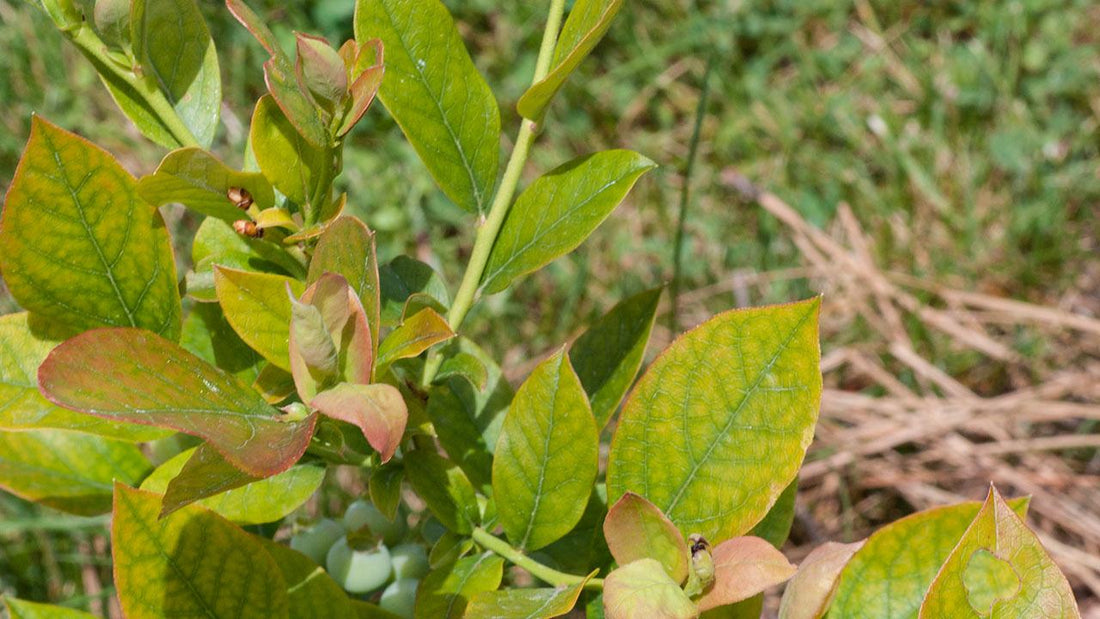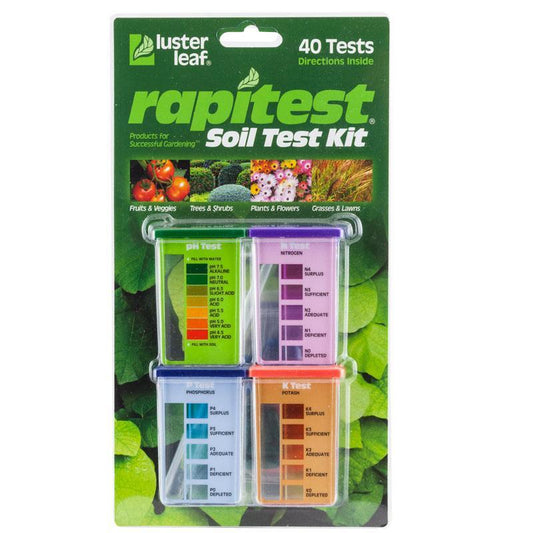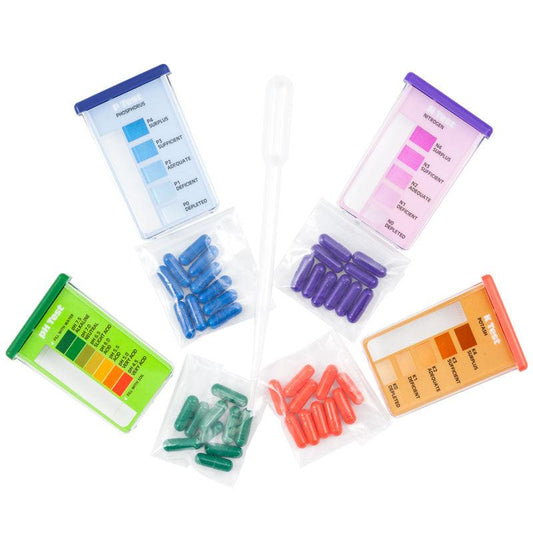Why Are My Blueberry Bush Leaves Turning Yellow?

When blueberry leaves turn yellow, it is often a sign of underlying issues with soil pH and nutrient availability. Healthy leaves are vital for photosynthesis, which fuels new growth and fruit development. It's important to know why blueberry leaves turn yellow and how to fix yellow leaves on blueberry bushes.
Understanding Blueberry Leaves Turning Yellow and Red
The leading cause of blueberry leaves turning yellow and red is iron deficiency or iron chlorosis. Plants with iron deficiencies show a unique yellow leaf pattern. The yellow blueberry leaf's veins stay dark green, while the rest of the leaf turns yellow, sometimes with red blotches. Yellow blueberry leaves with this pattern are a sign of iron deficiency or iron chlorosis.
Yellowed leaves on blueberry plants can negatively affect both the health of your plants and fruit production. Iron deficiencies happen when the soil pH is too high. This reduces the plant's ability to grow well. As a result, the plant often produces smaller and fewer berries.
How Soil Affects Blueberry Leaves Turning Yellow: Understanding Proper Soil pH for Healthy Blueberry Bushes

Blueberry plants prefer acidic soil, with a pH between 5.2 and 4.0, but optimally between 4.5 to 4.8. When the soil pH is outside this range, the plant cannot properly absorb nutrients, especially iron. Even if iron and other nutrients are in the soil, plants can't use the soil's iron when the soil pH is too high. As a result, the plant may suffer from iron deficiency or iron chlorosis.
Unhealthy plants with yellow leaves might also suffer from stunted growth or poorly developed young shoots. These signs also suggest the plant is struggling to absorb essential nutrients because of improper soil chemistry.
How to test if your soil pH is right for blueberry bushes.
It's important to test your soil to ensure the proper pH for blueberry plants. There are several different types of inexpensive pH test kits available. An easy-to-use NPK soil testing kit can measure your soil's pH level and help determine which amendments to use to adjust it. You can learn how to prepare a soil sample by watching Tricia's video about how to prepare a soil sample for pH testing.
How to fix blueberry plants' yellow leaves
If your test comes out with a high pH you can add iron sulfate or elemental sulfur in the recommended amounts to lower it. A pine needle mulch and the addition of peat moss will also help make the soil more acidic. You can also fertilize with an acidic fertilizer like Cottonseed Meal or Acid Mix. If your blueberries are growing in containers, a mix of half potting soil and half peat moss works well.
More Tips for Maintaining Healthy Blueberry Bush Leaves and Fruit Production
Besides pH, factors like sunlight, soil moisture, and good drainage can also impact your plant's health. Wet springs or too much watering can also lead to iron chlorosis. Waterlogged soils make it hard for plants to absorb oxygen and nutrients.
Using mulch like pine bark, peat moss, or other biodegradable options creates a protective layer. This layer helps keep moisture, adds organic matter, and improves soil structure.
Using ammonium sulfate regularly will help maintain nitrogen levels. This is important for the growth of canes and healthy green leaves before blooming and fruiting. More information about amending soil is detailed in this guide on using soil amendments.
To learn more, explore our blueberry growing guides and videos about planting and growing blueberries. Our blog about growing blueberry bushes in warm climates, helps you tailor plant care to your environment.
Conclusion

Closely monitoring foliage health and maintaining ideal soil conditions can prevent yellow leaves and help ensure your plants thrive. Maintaining the proper soil pH of 4.5 - 5.5 is key to preventing blueberry bush leaves turning yellow. It also helps prevent stunted growth of your plants caused by nutrient deficiencies.
Seasonal soil testing and amendments like elemental sulfur or iron sulfate help to keep your bushes healthy. If you notice your blueberry plant leaves turning yellow, act quickly to correct nutrient imbalances.
Following these care tips will help ensure healthy foliage and strong growth, ensuring a fruitful harvest. For quality plants, explore our selection of blueberry plants for sale.
FAQs about the Best Ways to Prevent Blueberry Leaves From Turning Yellow and Choosing the Right Soil for Blueberry Plants
Why are my blueberry leaves turning yellow?
How can I confirm that soil pH is causing the yellowing leaves?
What can I do to correct the soil pH for my blueberry plants?
How should I apply soil amendments to treat yellowing leaves
Will using mulch help my blueberry plants with yellowing leaves?
How often should I water my blueberry plants?
What should I do if new leaves are also turning yellow?
Can yellow leaves affect the growth of new canes and branches?
When is the best time to address yellowing leaves in blueberry plants?
Some blueberry cultivars are more tolerant of soil conditions than others. Research and plant cultivars that are best-suited to your local soil and climate. This will help reduce the risk of yellowing leaves and other issues.







20 comments
Rose, if your pH is in the correct range and you are still having issues with symptoms of iron deficiency, you should add an iron supplement. Ammonium sulfate is not an organic source of nitrogen.
Some of my blueberries have yellow leaves. I know is some deficiency of iron cause the ph if in between 4-5. Can I added a nitrogen like ammonium sulfate even am trying to grow it organic
Rose, clay soil can be acidic but the 50/50 mix will probably fine. I would test your pH after you make the mix to see where you are at with pH.
Eric, are the plants all getting the same amount of water and is the pH pretty consistent throughout the bed? What is your pH of your soil? You might try fertilizing with some acid-loving fertilizer, give it little iron and some trace minerals.
I have blueberries in containers but I want planted in the ground my soil is clay with 7.5 is above neutral can I mix canadian peat moss at rate of 50% and the other 50 of native soil which is clay